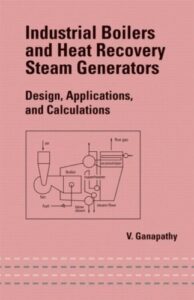Industrial Boilers and Heat Recovery Steam Generators: Design, Applications, and Calculations
Industrial Boilers and Heat Recovery Steam Generators: Design, Applications, and Calculations
Industrial Boilers and Heat Recovery Steam Generators: Design, Applications, and Calculations is about steam generators, HRSGs, and related systems. There are several excellent books on steam generation and boilers, and each has been successful in emphasizing certain aspects of boilers and related topics such as mechanical design details, metallurgy, corrosion, constructional aspects, maintenance,or operational issues.
This book is aimed at providing a different perspective on steam generators and is biased toward thermal and process design aspects of package boilers and HRSGs. (The terms ‘‘waste heat boiler’’ and ‘‘HRSG’’ are used in the same context.) My emphasis on thermal engineering aspects of steam generators reinforced by hundreds of worked-out real-life examples pertaining to boilers, HRSGs, and related systems will be of interest to engineers involved in a broad field of steam generator–related activities such as consulting, design, performance evaluation, and operation.
You can also Read Handbook of Natural Gas Transmission and Processing 3rd Edition
Industrial Boilers and Heat Recovery Steam Generators: Design, Applications, and Calculations Content
- preface
![Industrial Boilers]()
- Steam and Power Systems
- Heat Recovery Boilers
- Steam Generators
- Emission Control in Boilers and HRSGs
- Basic Steam Plant Calculations
- Fuels, Combustion, and Efficiency of Boilers and Heaters
- Fluid Flow, Valve Sizing, and Pressure Drop Calculations
- Heat Transfer Equipment Design and Performance
- Fans, Pumps, and Steam Turbines
- 1: A Quiz on Boilers and HRSGs
- 2: Conversion Factors
- 3: Tables
- Glossary
- Bibliography
The role of boilers and heat recovery steam generators (HRSGs) in the industrial economy has been profound. Boilers form the backbone of power plants, cogeneration systems, and combined cycle plants. There are few process plants, refineries, chemical plants, or electric utilities that do not have a steam plant. Steam is the most convenient working fluid for industrial processing,
heating, chilling, and power generation applications. Fossil fuels will continue to be the dominant energy providers for years to come.


Comments are closed.